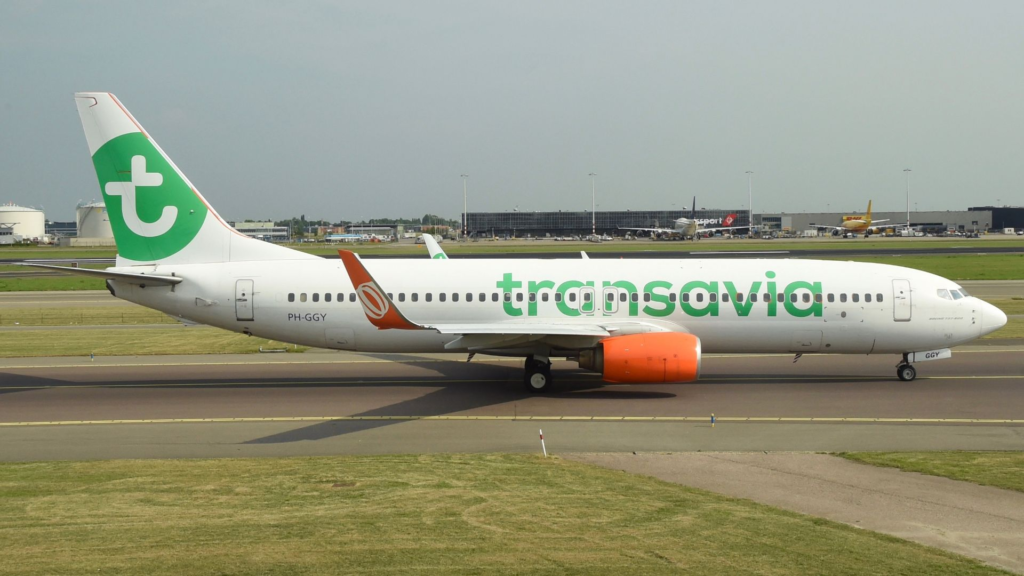On Monday, August 25, a Transavia Boeing 737-800 operating flight HV-5517 from Amsterdam to Cyprus was forced to return after the crew reported a technical problem shortly after departure. The jet landed back at  Amsterdam Schiphol Airport (AMS) without incident.
Amsterdam Schiphol Airport (AMS) without incident.
The airline has not disclosed details about the nature of the problem, though emergency services were deployed as a precaution. Early indications suggest the issue was related to the aircraft’s flight controls. The Boeing narrowbody remains on the ground at the airport following the incident.
Pilots Declared PAN PAN After Reporting Flight Control Anomalies On Transavia Boeing 737
The Boeing 737-800, registered PH-HXI, was operating a regular service between Amsterdam Schiphol Airport (AMS) and Paphos International Airport (PFO) in Cyprus. According to Flightradar24 data, the aircraft was scheduled to depart at 14:55 local time on August 25 and arrive in Paphos around 20:00. The flight left Schiphol at approximately 15:20 from runway 18L.
Shortly after departure, the crew stopped the climb at 8,000 feet to address a technical problem. They attempted to continue the flight in steps and requested clearances at 10,000 and 13,000 feet, as reported by The Aviation Herald. However, the situation later escalated, and the pilots declared a PAN PAN.
The crew cited anomalies with the flight controls that had first appeared during rotation. They told air traffic control (ATC) that they could not predict how the aircraft would behave, although it appeared stable under autopilot at that time. Ultimately, the crew requested a slow descent and return to the airport. The jet landed safely on runway 18C at Schiphol about 35 minutes after departure. It vacated the runway without issue and taxied back to the apron under its own power.
The Jet Remains Grounded, But Scheduled To Return To Service On August 27
At the time of writing, the aircraft remains grounded at Schiphol but is expected to return to service on August 27. Flightradar24 data shows PH-HXI is scheduled to operate flight HV6143 from Amsterdam to Alicante Airport in Spain. According to Planespotters.net, the aircraft is 8.4-year-old and was delivered to Transavia in April 2017. It is part of the carrier’s Boeing 737-800 fleet, which totals 38 aircraft.
As previously noted, initial reports suggest the issue may have involved the aircraft’s flight control system. However, the airline has not confirmed the exact nature of the fault. What is certain is that the crew issued a PAN PAN call to ATC. Pilots use specific phrases to communicate urgency or distress, and “PAN PAN” is one of the standard signals; it is the standard call for an urgency condition.
The phrase is often explained as “possible assistance needed” and is used to communicate an urgent, but not emergency, situation to ATC over VHF. In general aviation, this could apply to a pilot who has become disoriented or needs to climb to a higher altitude to resolve a problem. For an airliner, it can indicate the loss of a system that does not immediately compromise safety but may still require rerouting or a precautionary landing.
Furthermore, apart from this recent incident, the airline has faced other technical events this month involving its Boeing 737-800 fleet. On August 11, a jet registered PH-HSW operating flight HV-5514 from Faro to Eindhoven was forced to return to Faro after one of its CFM56 engines malfunctioned during the climb.
The aircraft landed safely about 23 minutes after departure, though passengers remained on board for nearly four hours before being disembarked. It remained grounded for more than a day and returned to service on August 13. A few days earlier, on August 6, another 737-800, registration PH-HSF, diverted to Lisbon while operating flight HV-3514 from Faro to Eindhoven Airport.
The crew reported an engine fire indication at cruising altitude, shut one engine down, and completed a safe landing on runway 02. Lisbon ATC placed other arrivals into holding patterns to accommodate the emergency. The aircraft involved showed signs of engine overheating on August 1 on a service from Rotterdam to Faro and this led to maintenance checks. According to the technical log, the problems may have been linked to a bird strike into the right-hand engine on July 12.






